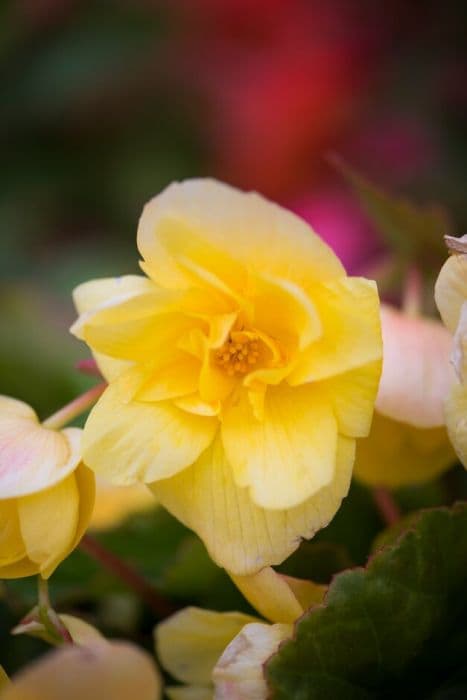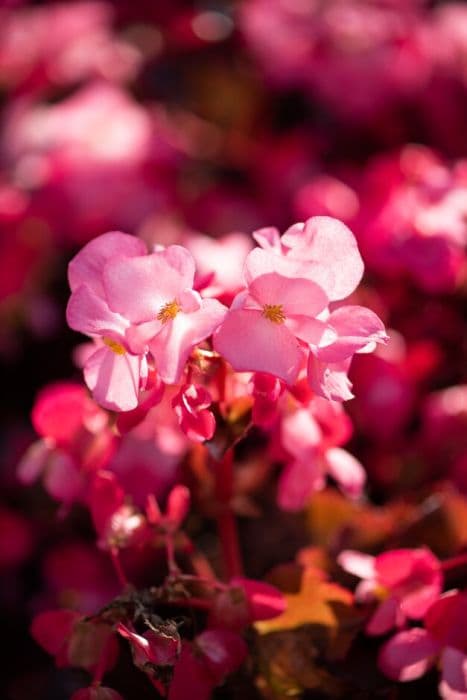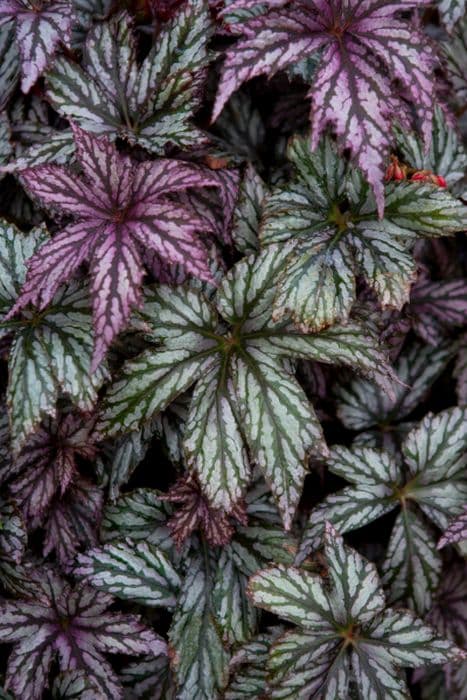Wax Begonia Begonia 'Olympia White' (Olympia Series) (S)

ABOUT
Begonia 'Olympia White' (Olympia Series) (S) is a striking plant notable for its lush foliage and vibrant blooms. The foliage consists of glossy green leaves with a slightly wavy or serrated edge, offering a beautiful backdrop for the flowers. The star attraction of this begonia is its pristine white blossoms which possess a delicate charm. Each flower is composed of multiple petals that create a rounded, full appearance, with a subtle, captivating symmetry. The blossoms cluster together in groups, creating a bountiful floral display that can brighten any garden or indoor space. The green foliage contrasted with the white flowers gives this plant a fresh and clean look that's often associated with purity and elegance.
About this plant
 Names
NamesFamily
Begoniaceae
Synonyms
Wax Begonia, Fibrous Begonia, Bedding Begonia
Common names
Begonia semperflorens
 Toxicity
ToxicityTo humans
Begonias, including the Olympia White begonia, are considered mildly toxic to humans. If ingested, they may cause irritation of the mouth, lips, tongue, and throat, possibly leading to nausea, vomiting, and difficulty in swallowing.
To pets
Begonias, which includes the Olympia White begonia, are also toxic to pets, particularly cats and dogs. If ingested, they can cause oral irritation, intense burning, and irritation of the mouth, tongue, and lips, excessive drooling, vomiting, and difficulty swallowing.
 Characteristics
CharacteristicsLife cycle
Annuals
Foliage type
Deciduous
Color of leaves
Green
Flower color
White
Height
6-12 inches (15-30 cm)
Spread
6-18 inches (15-45 cm)
Plant type
Herb
Hardiness zones
10
Native area
South America
Benefits
 General Benefits
General Benefits- Easy to Grow: Suitable for gardeners of all skill levels due to its low maintenance requirements.
- Bright Foliage: Features attractive green foliage that adds texture to garden spaces or indoor areas.
- Flowering Plant: Produces beautiful white blooms that enhance aesthetic appeal.
- Shade Tolerant: Thrives in shady areas where other flowering plants might struggle.
- Drought-Resistant: Once established, it can tolerate periods of dryness, making it ideal for varying climates.
- Compact Growth: Its compact size makes it suitable for small spaces, borders, and containers.
- Pest Resistant: Generally resistant to common garden pests, reducing the need for pesticides.
- Continuous Blooming: With proper care, it can provide flowers continuously throughout its blooming season.
- Attracts Pollinators: The flowers can attract butterflies and other beneficial pollinators to the garden.
 Medical Properties
Medical PropertiesThis plant is not used for medical purposes.
 Air-purifying Qualities
Air-purifying QualitiesThis plant is not specifically known for air purifying qualities.
 Other Uses
Other Uses- Begonia 'Olympia White' petals can be used to create a natural dye for fabrics, yielding a range of unique and subtle colors.
- The sap from the plant can be used as a base for cosmetic products such as lotions and creams, due to its potential soothing properties, when mixed with other non-allergenic ingredients.
- In botanical art, the distinct leaves and flowers of the Begonia can be pressed and preserved to create intricate designs and patterns for decoration or educational purposes.
- The leaves can be used in crafting to imprint their unique patterns onto paper or clay for creating textured designs in art projects.
- As a learning tool, the plant can be used in schools or educational programs to teach children about plant growth, horticulture, and the lifecycle of plants.
- When properly dried, the delicate flowers can be added to potpourri mixes for a gentle, pleasing scent.
- Begonia leaves can serve as organic mulch for other plants, providing nutrients to soil as they decompose.
- Enthusiasts of miniature fairy gardens use Begonia plants to create a white-themed or monochromatic garden scene due to their small size and vibrant white color.
- Used in photography, the white flowers provide a natural, serene backdrop for macro photography and plant portraiture.
- The Begonia can be incorporated into eco-friendly burial options where the biodegradable plant matter is used to create a more sustainable way to return nutrients to the earth.
Interesting Facts
 Feng Shui
Feng ShuiThe Begonia is not commonly referenced in traditional Feng Shui practice.
 Zodiac Sign Compitability
Zodiac Sign CompitabilityThe Begonia is not used in astrology practice.
 Plant Symbolism
Plant Symbolism- Caution: Begonias are often interpreted as a sign of caution. The mixed signals sent from the beautiful blooms contrasted with the toxic nature of the plant if ingested, prompts a message of warning or to proceed carefully in certain situations.
- Harmony: The balanced and orderly growth of the 'Olympia White' Begonia can symbolize harmony and balance in one's life, representing the idea of achieving inner peace and a harmonious existence.
- Individuality: With its unique white blossoms, the 'Olympia White' Begonia encourages individuality and standing out. It inspires one to embrace their unique qualities and express their true self.
- Gratitude: Begonias can symbolize gratitude or deep appreciation. Giving someone a begonia may express your thanks for their help or to acknowledge their influence in your life as something that has been beneficial.
 Water
WaterFibrous begonias, like the Begonia 'Olympia White', prefer consistent moisture and should be watered when the top inch of soil feels dry to the touch. This may mean watering about once a week, but the frequency can depend on the humidity and temperature of your environment. Use lukewarm water to avoid shocking the plant’s roots, and gently water the soil at the base of the plant with approximately 16 ounces every watering session, taking care not to saturate the soil.
 Light
LightThe Begonia 'Olympia White' thrives in bright, indirect sunlight. A spot near an east or west-facing window where it can receive gentle morning or afternoon sun would be ideal. Avoid placing it in direct, harsh sunlight as this can scorch the leaves.
 Temperature
TemperatureFibrous begonias like the Begonia 'Olympia White' prefer temperatures between 60 and 75 degrees Fahrenheit. They can survive in temperatures as low as 50 degrees Fahrenheit and as high as 86 degrees Fahrenheit, but prolonged exposure to temperatures outside of their ideal range can stress the plant.
 Pruning
PruningPrune the Begonia 'Olympia White' to maintain its shape and encourage bushier growth. Snip off dead or dying leaves and spent flowers to promote new growth and improve air circulation. The best time for pruning is in the spring, and occasional light pruning can be done throughout the growing season.
 Cleaning
CleaningAs needed
 Soil
SoilFor Begonia 'Olympia White', a well-draining soil mix is ideal, comprising peat moss, perlite, and vermiculite in equal parts. The soil pH should be slightly acidic to neutral, ranging from 5.5 to 6.5.
 Repotting
RepottingBegonia 'Olympia White' should be repotted every 1-2 years or when it becomes root-bound. The best time to repot is in the spring.
 Humidity & Misting
Humidity & MistingBegonia 'Olympia White' thrives in moderate to high humidity levels, ideally between 50% and 70%.
 Suitable locations
Suitable locationsIndoor
Place in bright, indirect light and keep soil moist.
Outdoor
Partial shade, protect from strong sun and heavy rain.
Hardiness zone
10-11 USDA
 Life cycle
Life cycleThe life of Begonia 'Olympia White' begins with seed germination, which typically occurs in moist, warm soil conditions in spring. Following germination, the seedlings emerge and develop into juvenile plants, where the iconic asymmetrical leaves begin to form. As the plant matures, it enters the vegetative growth stage, producing lush foliage and establishing a strong root system. This is followed by the flowering stage, where 'Olympia White' produces clusters of white blossoms against its green foliage throughout the summer months, attracting pollinators. After pollination, the flowers develop into seed capsules, which when mature, release seeds to complete the reproductive cycle. Over time or with adverse conditions, the plant may enter a period of dormancy or die back, especially in colder climates, but it is typically treated as an annual and replanted each year.
 Propogation
PropogationPropogation time
Spring-Early Summer
Begonia 'Olympia White', commonly known as fibrous begonia, is most commonly propagated through stem cuttings. This method involves snipping a stem that is 3 to 4 inches long (about 7.5-10 centimeters), just below a leaf node, during the active growing season, which is typically spring or early summer. To encourage rooting, it is beneficial to dip the cut end into rooting hormone powder before planting the cutting in a moist, well-draining potting mix. Ensuring the ambient temperature is between 72-75 degrees Fahrenheit (around 22-24 degrees Celsius), the cutting should be placed in a location with bright, indirect light. To retain a high humidity level, it's advisable to cover the pot with a clear plastic bag, making sure it doesn't touch the leaves. Roots often emerge within a few weeks, after which the new plant can be gradually acclimated to less humid conditions and eventually moved to a more permanent location.





![Begonia [Devotion]](/_next/image?url=https%3A%2F%2Fplants-admin.emdemapps.com%2Fimages%2Fplants%2F%2Fimages%2F604b58183573b.png&w=640&q=75)



